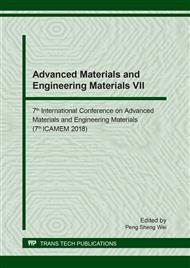[1]
S. Janbuala, U. Kitthawee, M. Aermbua, P. Laoratanakul, Effect of rice husk ash to mechanical properties of clay bricks, Adv. Mater. Res. 77 (2013) 50–53.
DOI: 10.4028/www.scientific.net/amr.770.50
Google Scholar
[2]
S. Janbuala, T. Wasanapiarnpong, Effect of rice husk and rice husk ash on properties of lightweight clay bricks, Key Eng. Mater. 659 (2015) 74–79.
DOI: 10.4028/www.scientific.net/kem.659.74
Google Scholar
[3]
C. Bories, M. Borredon, E. Vedrenne, G. Vilarem, Development of eco-friendly porous fired clay bricks using pore-forming agents: A review, J. Environ. Manage. 143 (2014) 186–196.
DOI: 10.1016/j.jenvman.2014.05.006
Google Scholar
[4]
L. Zhang, Production of bricks from waste materials – A review, Constr. Build. Mater. 47 (2013) 643–655.
Google Scholar
[5]
P. Muñoz Velasco, M.P. Morales Ortíz, M. Mendívil Giró, L. Muñoz Velasco, Fired clay bricks manufactured by adding wastes as sustainable construction material – A review, Constr. Build. Mater. 63 (2014) 97–107.
DOI: 10.1016/j.conbuildmat.2014.06.023
Google Scholar
[6]
G. Gorhan, O. Simsek, Porous clay bricks manufactured with rice husks, Constr. Build. Mater. 40 (2013) 390–396.
DOI: 10.1016/j.conbuildmat.2012.09.110
Google Scholar
[7]
I. Demir., S. Baspınar, M Orhan, Utilization of kraft pulp production residues in clay brick production, Build. Enviro. 40 (2005) 1533–1537.
DOI: 10.1016/j.buildenv.2004.11.021
Google Scholar
[8]
C. Bories, M. Borredon, E. Vedrenne, G. Vilarem, Fired clay bricks using agricultural biomass wastes: Study and characterization, Constr. Build. Mater. 91 (2015) 158–163.
DOI: 10.1016/j.conbuildmat.2015.05.006
Google Scholar
[9]
K.C.P. Faria, R.F. Gurgel, J.N.F. Holanda, Recycling of sugarcane bagasse ash waste in the production of clay bricks, J. Environ. Manage. 101 (2012) 7–12.
DOI: 10.1016/j.jenvman.2012.01.032
Google Scholar
[10]
I. Demir, Effect of organic residues addition on the technological properties of clay bricks, Waste Manage. 28 (2008) 622–627.
DOI: 10.1016/j.wasman.2007.03.019
Google Scholar
[11]
Y. Abali, M.A. Yurdusev, S. Zeybek, A.A. Kumanlıoglu, Using phosphogypsume and boron concentrator wastes in light brick production, Constr. Build. Mater. 21 (2007) 52–56.
DOI: 10.1016/j.conbuildmat.2005.07.009
Google Scholar
[12]
D. Eliche-Quesada, C. Martínez-García, M.L. Martínez-Cartas, M.T. Cotes-Palomino, L. Pérez-Villarejo, N. Cruz-Pérez, F.A. Corpas-Iglesias, The use of different forms of waste in the manufacture of ceramic bricks, Appl. Clay Sci. 52 (2011).
DOI: 10.1016/j.clay.2011.03.003
Google Scholar
[13]
M. Sutcu, S. Akkurt, The use of recycled paper processing residues in making porous brick with reduced thermal conductivity, Ceram. Int. 35 (2009) 2625–2631.
DOI: 10.1016/j.ceramint.2009.02.027
Google Scholar
[14]
ASTM C373 – Test Method for Water Absorption, bulk density, apparent porosity, and apparent specific gravity of fired whitewater products, American society for testing and materials, (1994).
DOI: 10.1520/c0373-16
Google Scholar
[15]
N.S. Raut, P. Biswas, T.K. Bhattacharya, K. Das, Effect of bauxite addition on densification and mullitization behavior of West Bengal clay, Bull. Mater. Sci. 31 (2008) 995–999.
DOI: 10.1007/s12034-008-0156-4
Google Scholar
[16]
F.A.C. Milheiro, M.N. Freire, A.G.P. Silva, J.N.F. Holanda, Densification behavior of a red firing Brazilian kaolinitic clay, Ceram. Int. 31 (2005) 757–763.
DOI: 10.1016/j.ceramint.2004.08.010
Google Scholar
[17]
Thailand Industrial Standard Institute, Thai industrial standard of pottery brick TISI 77 (2002).
Google Scholar
[18]
P. Mishra, A. Chakraverty, H.D. Banerjee, Studies on physical and thermal properties of rice husk related to its industrial application, J. Mater. Sci. 21 (1986) 2129–2132.
DOI: 10.1007/bf00547958
Google Scholar


